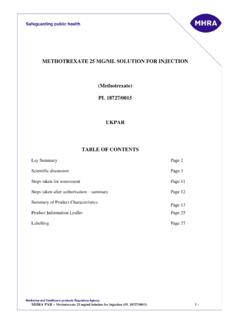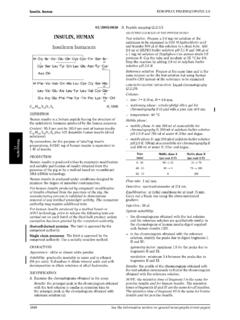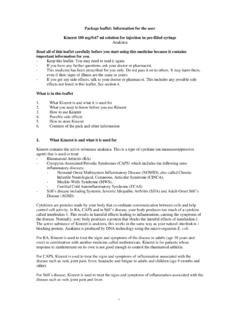Transcription of Mitomycin for Injection USP, 5 and 20 mg - PIL - …
1 Version 1 NEW ZEALAND DATA SHEET 1. PRODUCT NAME Mitomycin , Powder f or Injection , 5 mg /vial 2. QUALITATIVE AND QUANTITATIVE COMPOSITION Each vial contains Mitomycin 5 mg . For full list of excipients, see section 3. PHARMACEUTICAL FORM Powder for solution for Injection . Blue-violet cake or powder. 4. CLINICAL PARTICULARS Therapeutic indications Mitomycin for Injection is not recommended as single-agent, primary therapy. It has been shown to be useful in the therapy of disseminated adenocarcinoma of the stomach or pancreas in proven combinations with other approved chemotherapeutic agents and as palliative treatment when other modalities have failed. Mitomycin is not recommended to replace appropriate surgery and/or radiotherapy. Dose and method of administration Dose: Parenteral drug products should be inspected visually for particulate matter and discoloration prior to administration whenever solution and container permit.
2 Mitomycin should be given intravenously only, using care to avoid extravasation of the compound. If extravasation occurs, cellulitis, ulceration, and slough may result. Each vial contains either Mitomycin 5 mg and mannitol 10 mg. To administer, add Sterile Water for Injection , 10 mL. Shake to dissolve. If product does not dissolve immediately, allow to stand at room temperature until solution is obtained. After full haematological recovery (see guide to dosage adjustment) from any previous chemotherapy, the following dosage schedule may be used at 6 to 8 week intervals: 20 mg /m2 intravenously as a single dose via a functioning intravenous catheter. Because of cumulative myelosuppression, patients should be fully reevaluated after each course of Mitomycin , and the dose reduced if the patient has experienced any toxicities.
3 Doses greater than 20 mg /m2 have not been shown to be more effective, and are more toxic than lower doses. The following schedule is suggested as a guide to dosage adjustment: Nadir After Prior Dose Leukocytes/mm3 Platelets/mm3 Percentage of Prior Dose to be Given > 4000 > 100,000 100% 3000 - 3999 75,000 - 99,999 100% 2000 - 2999 25,000 - 74,999 70% < 2000 < 25,000 50% No repeat dosage should be given until leukocyte count has returned to 4000/mm3 and a platelet count to 100,000/mm3. Version 2 When Mitomycin is used in combination with other myelosuppressive agents, the doses should be adjusted accordingly. If the disease continues to progress after two courses of Mitomycin , the drug should be stopped since chances of response are minimal. Contraindications Mitomycin is contraindicated in patients who have demonstrated a hypersensitive or idiosyncratic reaction to it in the past.
4 Mitomycin is contraindicated in patients with thrombocytopenia, coagulation disorder, or an increase in bleeding tendency due to other causes. Special warnings and precautions for use Patients being treated with Mitomycin must be observed carefully and frequently during and after therapy. The use of Mitomycin results in a high incidence of bone marrow suppression, particularly thrombocytopenia and leukopenia. Therefore, the following studies should be obtained repeatedly during therapy and for at least eight weeks following therapy: platelet count, white blood cell count, differential, and hemoglobin. The occurrence of a platelet count below 100,000/mm3 or a WBC below 4,000/mm3 or a progressive decline in either is an indication to withhold further therapy until blood counts have recovered above these levels.
5 Patients should be advised of the potential toxicity of this drug, particularly bone marrow suppression. Deaths have been reported due to septicaemia as a result of leukopaenia due to the drug. Patients receiving Mitomycin should be observed for evidence of renal toxicity. Mitomycin should not be given to patients with a serum creatinine greater than mg percent. Acute shortness of breath and severe bronchospasm have been reported following the administration of vinca alkaloids in patients who had previously or simultaneously received Mitomycin . The onset of this acute respiratory distress occurred within minutes to hours after the vinca alkaloid Injection . The total number of doses for each drug has varied considerably. Bronchodilators, steroids and/or oxygen have produced symptomatic relief. A few cases of adult respiratory distress syndrome have been reported in patients receiving Mitomycin in combination with other chemotherapy and maintained at FIO2 concentrations greater than 50% perioperatively.
6 Therefore, caution should be exercised using only enough oxygen to provide adequate arterial saturation since oxygen itself is toxic to the lungs. Careful attention should be paid to fluid balance and overhydration should be avoided. Bladder fibrosis/contraction has been reported with intravesical administration (not an approved route of administration), which in rare cases has required cystectomy. Paediatric population Safety and effectiveness in paediatric patients have not been established. Elderly Insufficient data from clinical studies of Mitomycin are available for patients 65 years of age and older to determine whether they respond differently than younger patients. Postmarketing surveillance suggests that elderly patients may be more susceptible than younger patients to Injection site reactions (see section Undesirable effects: Integument and Mucous Membrane Toxicity) and hypersensitivity reactions.
7 In general, caution should be exercised when prescribing to elderly patients, reflecting the greater frequency of decreased hepatic, renal, or cardiac function, and of concomitant disease or other drug therapy. Version 3 Interaction with other medicines and other forms of interaction Myelotoxic interactions with other bone marrow-toxic treatment modalities (especially other cytotoxic medicinal products, radiation) are possible. Combination with vinca alkaloids or bleomycin may reinforce pulmonary toxicity. An increased risk of haemolytic-uremic syndrome has been reported in patients receiving a concomitant administration of Mitomycin and fluorouracil or tamoxifen. In animal experiments, pyridoxine hydrochloride (vitamin B6) resulted in the loss of effect of Mitomycin .
8 No injections with live vaccines should be carried out in connection with Mitomycin treatment. The cardiotoxicity of Adriamycin (doxorubicin) may be reinforced by Mitomycin . Fertility, pregnancy and lactation Fertility The effect of Mitomycin on fertility is unknown. Pregnancy Safe use of Mitomycin in pregnant women has not been established. Teratological changes have been noted in animal studies. Lactation It is not known if Mitomycin is excreted in human milk. Because many drugs are excreted in human milk and because of the potential for serious adverse reactions in nursing infants from Mitomycin , it is recommended that nursing be discontinued when receiving Mitomycin therapy. Effects on ability to drive and use machines Even when used in accordance with instructions these medicinal products may cause nausea and vomiting and thereby reduce reaction times to such an extent that the ability to drive a motor vehicle or operate machinery is impaired.
9 This applies even more in connection with alcohol. Undesirable effects Bone Marrow Toxicity This was the most common and most serious toxicity, occurring in 605 of 937 patients ( ). Thrombocytopenia and/or leukopenia may occur anytime within 8 weeks after onset of therapy with an average time of 4 weeks. Recovery after cessation of therapy was within 10 weeks. About 25% of the leukopenic or thrombocytopenic episodes did not recover. Mitomycin produces cumulative myelosuppression. Integument and Mucous Membrane Toxicity This has occurred in approximately 4% of patients treated with Mitomycin . Cellulitis at the Injection site has been reported and is occasionally severe. Stomatitis and alopecia also occur frequently. Rashes are rarely reported. The most important dermatological problem with this drug, however, is the necrosis and consequent sloughing of tissue which results if the drug is extravasated during Injection .
10 Extravasation may occur with or without an accompanying stinging or burning sensation and even if there is adequate blood return when the Injection needle is aspirated. There have been reports of delayed erythema and/or ulceration occurring either at or distant from the Injection site, weeks to months after Mitomycin , even when no obvious evidence of extravasation was observed during administration. Skin grafting has been required in some of the cases. Elderly patients may be more susceptible than younger patients to Injection site reactions (see section Special warnings and precautions for use: Elderly). Version 4 Renal Toxicity 2% of 1,281 patients demonstrated a statistically significant rise in creatinine. There appeared to be no correlation between total dose administered or duration of therapy and the degree of renal impairment.
















